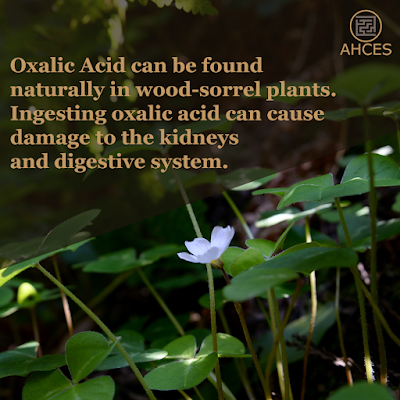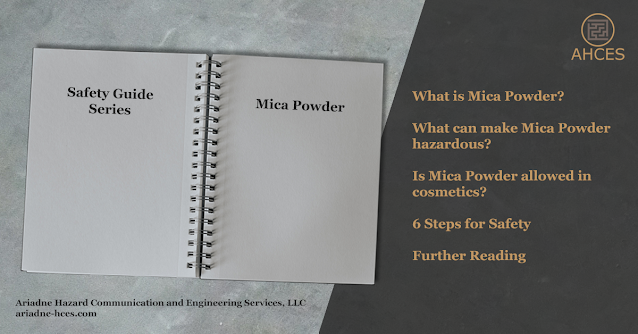Oxalic Acid Safety Guide
What is Oxalic Acid?
Oxalic Acid is a dicarboxylic acid naturally produced by plants of the genus Oxalis, also known as wood-sorrels. Oxalic acid has many uses including in rust removal and other household cleaners, bleaching agents for wood pulp, and as a mordant in the dyeing process.
Oxalic Acid the CAS Number 144-62-7.
The CAS Number is used to identify oxalic acid as an ingredient on safety data sheets (SDS) and other safety documentation. When looking for oxalic acid as an ingredient in cleaning products, bleaches, and mordants, look for the CAS Number within the composition table.
Notable Properties of Oxalic Acid
Pure oxalic acid is a white, odorless crystalline solid, typically found in powder form. Any color or odor comes from natural impurities or other ingredients within the oxalic-acid-based product.
What Makes Oxalic Acid Hazardous?
Oxalic acid is, as the name suggests, an acidic substance. It can cause irritation to the eyes, skin, and respiratory system. Symptoms of oxalic acid irritation include burning and redness of the skin and eyes, localized pain, and difficulty breathing. If ingested, oxalic acid can also cause kidney damage, in extreme cases leading to shock and convulsions.
Due to being a carbon-based substance, oxalic acid can also form combustible dusts and create a fire hazard.
Oxalic Acid Frequently Asked Questions
Is Oxalic Acid Organic?
Oxalic Acid is organic by the definition that it is a molecule with carbon-carbon bonds.
Since oxalic acid can be naturally derived from plants grown to the USDA certified organic standards, oxalic acid can also fall under that definition of organic.
Is Oxalic Acid Harmful to Humans? Is Oxalic Acid Toxic?
Oxalic acid can be harmful to humans. Per the Toxin and Toxin Target Database, oxalic acid is not metabolized by the body. However, oxalic acid will bond with metal ions, such as Ca2+, Fe2+, and Mg2+, forming a metal oxalate which is irritating to the digestive system and kidneys. A buildup of calcium oxalate can cause kidney stones, with either acute or chronic consumption having the potential to cause kidney damage.
As the mechanism of harm to the body system is not specific to the human body, oxalic acid can also be harmful to other animals that ingest it, including pets.
Is Oxalic Acid Harmful to Skin?
As an acid, oxalic acid is irritating to the skin. Prolonged contact, especially at higher concentrations, can cause chemical burns.
Will Oxalic Dissolve in Water? Is Oxalic Acid Soluble?
Oxalic acid is soluble in water, ethanol, and ether.
Does Oxalic Acid Remove Rust?
Oxalic acid is an ingredient in some rust removal products. This works by the oxalic acid and iron within the rust reacting, forming iron oxalate, which is water soluble and can be washed off the iron surface being cleaned.
6 Steps for Safety
Step 1: Read the Warnings
When working with a product for the first time, always read all the safety documents first. This includes safety data sheets, which should be provided by the manufacturer or importer of the oxalic acid powder. There may also be an OSHA chemical label, FDA cosmetics label, or a Consumer Protection label on the packaging of the oxalic acid powder product. These documents all contain important information on the hazards of the product and instructions on how to mitigate those hazards.
Different compositions in different products may cause additional hazards to be present beyond the properties of plain oxalic acid powder. Be sure to familiarize yourself with the differences between separate oxalic acid products.
Step 2: Prepare Your Workspace
Creating a safe workspace, sometimes referred to as engineering control, is a key component of working safely with any potentially hazardous substance.
Since the primary hazard of oxalic acid powder is the fine dust, both as an irritant and as a combustible dust, ventilation is important. Fans which would blow oxalic acid powder around should be avoided. Dust collectors and air filters which draw in and capture any stray oxalic acid powder are ideal.
Step 3: Gather Your PPE
For oxalic acid, you will need the following PPE.
- Respiratory Protection
- A half-facepiece respirator with filters rated for protection against fine organic dust.
- A full-facepiece respirator can serve as both respiratory protection and eye protection.
- Eye Protection
- Safety goggles which create a seal around the eyes are needed to prevent any airborne oxalic acid from reaching the eyes.
- Open safety glasses, which do not have a sealing surface, will not work in preventing dust from reaching the eyes.
- Gloves
- Basic disposable gloves will prevent oxalic acid from touching the skin on the hands and causing irritation.
- Long Sleeves
- Long sleeves will prevent oxalic acid from touching the skin on the arms and causing irritation.
- Either a long-sleeved shirt, long-sleeved coat, or disposable sleeves will work.
- Launder any contaminated closing separately to prevent cross-contamination and inform anyone laundering the clothing of the presence of oxalic acid so they can take any necessary precautions.
Step 4: Clear Your Workspace
Having a clear workspace is an important part of safety. Clutter can cause accidents and can prevent you from noticing if something has spilled.
This is also a good time to double-check check any engineering controls, like a dust collector, are in proper working order and that no filters need to be changed out.
If you are working in a shared space, make sure anyone around you can also remain safe when you are working with oxalic acid. For those working at home, this can include family members and pets.
Step 5: Do The Work
If engineering controls and PPE are used properly, working with oxalic acid has minimal hazards.
If work cannot be completed in one sitting, be sure to properly seal any oxalic acid containers to prevent spills or accidental release when not in use.
Step 6: Clean Up
Dust generation should be avoided when cleaning up. Either a vacuum with a filter or a damp cleaning cloth can be used to pick up spilled or stray oxalic acid powder while preventing dust generation.
Be sure to dispose of any waste in accordance with local regulations, which can vary by State and county.
Further Reading
The National Library of Medicine has a PubChem article on Oxalic Acid as well as a HazardousSubstances Database Entry. The National Institute for Occupational Safety and Health (NIOSH) also has an Oxalic Acid pocket guide.
Check out the Safety Guide Series Hub for more safety guides.
Sources Cited
National Center for Biotechnology Information (2024). PubChem Compound Summary for CID 971, Oxalic Acid. Retrieved May 17, 2023 from https://pubchem.ncbi.nlm.nih.gov/compound/Oxalic-Acid.
National Center for Biotechnology Information (2024). PubChem Annotation Record for , OXALIC ACID, Source: Hazardous Substances Data Bank (HSDB). Retrieved February 12, 2024 from https://pubchem.ncbi.nlm.nih.gov.
National Institute for Occupational Safety and Health (2019, October 30). Oxalic acid. Cdc.gov. Retrieved May 17, 2023, from https://www.cdc.gov/niosh/npg/npgd0474.html
Original Posting Date: May. 17, 2023
Last Updated: Feb. 12, 2024






Comments
Post a Comment